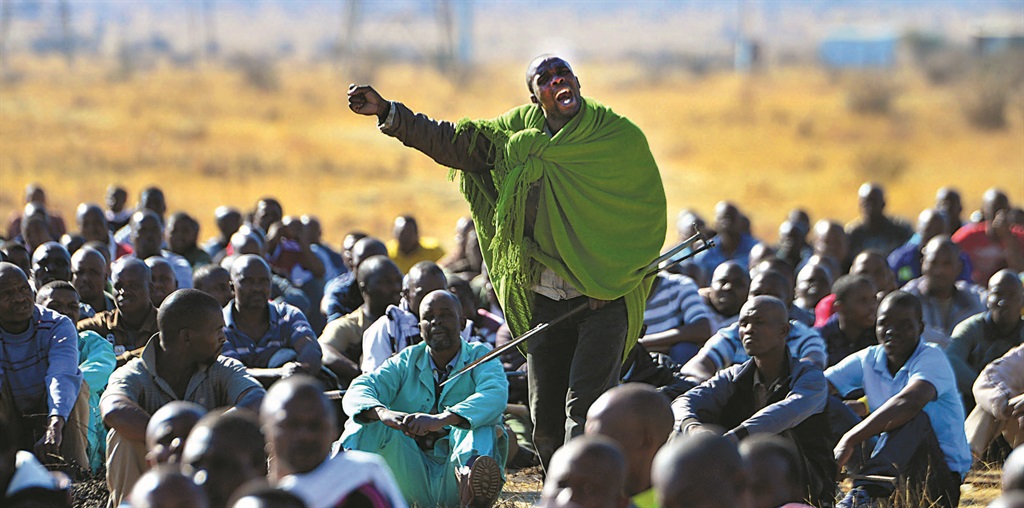
As we approach the four-year commemoration of the Marikana massacre, the time must come to reflect in new ways on its unsung heroes.
Marikana is not solely a sad story about how workers were massacred by the police. It is also about how rank-and-file workers at one point in time exercised great power.
The book The Spirit of Marikana: The Rise of Insurgent Trade Unionism in South Africa focuses on individuals and their relationship to the collective.
It attempts to uncover the leadership practices of a few key “organic” intellectuals – organic, in the league of neo-Marxist theorist Antonio Gramsci.
These leaders played an indispensable role in the development of the 2012 and 2014 platinum belt strikes – and, perhaps more crucially, in the events immediately preceding them.
Explanations of the events leading up to the 2012/14 platinum belt wave of strikes fall short in revealing why the origins of the strikes can be traced back to certain moments in time and specific mine shafts.
Understanding these dynamics requires a sociological examination of mine workers directly involved in the strikes.
A primary step to piecing together a narrative which helps explain the origins of the strikes is to identify key leaders and uncover hidden histories.
As organic intellectuals in the Gramscian sense, these individuals developed counter-hegemonic ideologies rooted within the material conditions and discourses of their fellow workers.
Both strikes were perceived as spontaneous uprisings involving employees who used violence and intimidation to maintain solidarity, be it among other employees or nonstrikers. No credence was given to democratic leadership and the element of persuasion.
While these workers’ leaders (through their committees) provided the way forward, they were led by – and were directly accountable to – the rank and file.
Accounts of the 2012 unprotected strike at Lonmin make much of the leader known as Mambush, implying that he led the workers throughout.
However, careful ethnographic research, which we undertook over the period between 2012 and 2015, indicates that he was not one of the rock-drill operators who initiated it.
While the initial involvement of many mine workers occurred spontaneously, the involvement of a handful of those who became leaders at various points before, during and after the strikes did not.
Without their strategic efforts to engage within – and, where necessary, to create – informal networks for the mobilisation of the strikers, events might not have occurred in the moment and manner in which they did.
For socialist activists working closely with the workers in the platinum belt, it appeared that the unprotected strikes of 2012 were the pinnacle of resistance, and that a swift decline in mobilisation was likely to follow as a result of workers and their leaders’ decision to join what appeared to be a top-down, authoritarian union.
The Association of Mineworkers and Construction Union (Amcu) was opposed to the unprotected strike that workers’ committees led and sustained in 2012. It seemed to many observers, myself included, that under the banner of the new union, unprotected strikes were not an option, and worker militancy would soon perish.
In fact, it became clear that the politics that underpinned the militant strikes of 2012 remained constant over time, despite workers’ decision to join a union and to engage primarily in protected strikes. Hence the 2014 strike, which was tronger and longer.
In other words, this case shows that when the rank and file take on an insurgent identity, the trade union’s official power becomes relatively marginal.
Just as the exclusive nature of the National Union of Mineworkers (NUM) provided the structural basis for new forms of organisation to emerge (that is worker committees), worker committees created the political space, or at least the possibility, for an insurgent trade union such as Amcu to flourish.
The new structural context constrained certain practices and ideas, and enabled others. There had been a narrow arena in which workers reluctantly accepted that they should strike to demand a pay rise of about 10% under the auspices of the NUM.
The new politics created an open space to engage in what workers thought they needed to live decently. So, instead of being based on what management would consider rational, mine workers based their demands on the amount of money which they considered a living wage. They settled on R12 500.
Amcu is the product of the militant labour struggles – in this case, the relatively short-lived but very powerful workers’ committees – in the platinum mines. Leaders of these committees at Anglo American Platinum, Impala Platinum and Lonmin organised independently of unions and embarked on unprotected strikes.
When these strikes ended, worker leaders – in dialogue with management – believed they needed a union to represent them. They chose Amcu. The union began to champion the radical wage demand of R12 500, since rank-and-file workers had died on the mountain in Marikana, waiting for their employer to come and negotiate for that amount.
Amcu head Joseph Mathunjwa took the R12 500 demand and made it his union’s pillar. In a sense, Amcu and Mathunjwa’s rise to prominence in the platinum belt has been drawn out of the blood of the 34 mine workers killed during the Marikana massacre. One prominent Amcu T-shirt, proudly worn by mine workers in the platinum belt, reads: “Never forget: We died for a living wage … The struggle continues.”
The concept of insurgent trade unionism helps us to analyse the relationship between two periods of time: 2012, when workers went on unprotected strikes with their independent committee at the helm; and 2014, when workers went on protected strikes under the Amcu banner.
The trade union of 2014 was not an ordinary phenomenon. It came to power following a massive upheaval. The notion of insurgent trade unionism highlights the diversity of existing union practices, and how they change over time according to shifting circumstances.
Most importantly, it reveals the ways in which trade unions may be driven from below by the rank and file’s collective and, in this case, insurgent agency. However, it also points to new struggles within the union as well as with management.
Sinwell is a senior researcher at the University of Johannesburg and Mbatha is a coordinator of the Thembelihle Crisis Committee. They are co-authors of The Spirit of Marikana: The Rise of Insurgent Trade Unionism in South Africa, published by Wits University Press.




 Publications
Publications
 Partners
Partners








